The world of sales is as cutthroat as it gets.
Metrics to keep track of, goals to meet, managers breathing down your neck at all times, there's so much going on all at once.
But we're not talking about regular old sales here, we're talking about SaaS sales. And with that comes a whole new set of rules to follow. New metrics to track. An entirely different mindset.You've got the leads. You've designed a captivating website. Your SaaS marketing strategy is on point. So what's next? Where do you go from here?
Well, now it's time to turn those leads you've gained into paying, happy customers. With the right SaaS lead generation strategy and the right mindset, you'll be on your way to boosting your revenue in no time.
What Are SaaS Sales?
Salespeople are everywhere. From cars to real estate, even the cell phone you might be browsing on as we speak. However, these are physical products. The sales strategies in place for products like these vary drastically from those used in selling SaaS products.
So how do SaaS sales stand out from the crowd?
SaaS Sales Definition
To put it as simple as it gets, SaaS sales are all about getting your SaaS products or services into the hands of your leads generated from your SaaS marketing strategy.
Similar to SaaS marketing, SaaS sales present their own list of challenges to overcome. Simply knowing what SaaS sales are isn't enough to be successful in converting those leads into paying customers. Even those companies who have found great success in SaaS marketing their services can tell you that. After your marketing strategies have brought a lead to the buying table, it's up to the sales team to convert that lead.
|
SaaS Marketing |
SaaS Sales |
|
Identifies target market |
Turns leads into customers |
|
Creates inbound or outbound strategy |
Upsells where possible to maximize revenue |
|
Generates potential leads |
Follows up with paying customers |
Success in SaaS sales is all about demonstrating the value your service can provide the customer if nothing else.
Take Airbnb, for example. They went from selling cereal based on the 2008 presidential election to fund their startup to a company valued at over 30 billion dollars. They didn't accomplish this by slacking in the sales department!
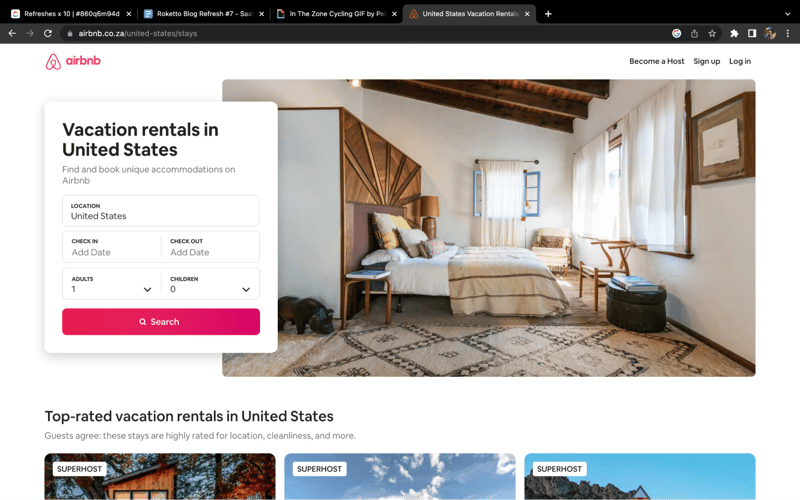
SaaS Sales vs. Regular Sales
As you already know, SaaS sales differ greatly from regular product sales. It's nothing like selling a used car at a car lot!
|
Regular Product Sales |
SaaS Sales |
|
Don't usually have a trial period |
Rely on trial periods to convert |
|
Typically one and done sale |
Lifetime customers |
|
Little to no upsell potential |
Huge revenue boost from upselling |
Understanding the key differences between the two and capitalizing on the advantages of selling a service rather than a physical product is what will boost your revenue to the next level.
For example, while many salesmen who sell products that are one-off sales typically don't follow up with their customers, the follow-up is vital to SaaS sales. Especially during the trial phase when your prospect is deciding whether or not to upgrade to the full version!
How the Sales Funnel SaaS Works?
There are four stages of a SaaS sales funnel. However, the traditional sales funnel approach is utilized as the foundation of a SaaS funnel. One main difference between the pipeline is the focus on customer retention during the SaaS sales process.
Regular payments and upgrades help develop monthly recurring revenue (MRR) and form the basis of SaaS client retention strategies. Customers who make a one-time payment tend to be less loyal than patrons who pay monthly.
The table below highlights the four phases of a sales funnel for a SaaS business:
|
Stage |
Description |
Goal |
Key Activity |
|
Awareness |
Prospects become aware of the SaaS product through marketing efforts such as content marketing, social media, and advertising. |
Create brand awareness and generate leads. |
Content creation, social media marketing, paid advertising, search engine optimization (SEO), lead generation through landing pages and forms. |
|
Engagement |
This stage involves engaging the customer with a volley of questions that can help you establish rapport. Potential clients could subscribe to your mailing list, download an ebook, or access gated content to get them engaged with your brand. |
Build enough credibility before the customer is shown the demo app |
Email marketing, lead nurturing, free trial sign-ups, content downloads, webinars, demos, lead scoring and qualification. |
|
Exploration |
The customer feels more comfortable describing their issues with sales reps. They display a willingness to explore various aspects of the solutions and visualize how it could assist them. |
Qualify leads and capture prospects' attention |
Case studies, testimonials, and other social proof |
|
Conversion |
Once the previous efforts have warmed the prospect up, it's time to close the deal. The software's demos should close the deal for you. |
Convert paying leads into customers |
Subscription sign-up, purchase process, contract signing, payment collection, onboarding and implementation, customer success activities, upselling and cross-selling. |
Please note that the activities and stages in a SaaS sales funnel may vary depending on the specific organization, SaaS sales cycle, and target audience. It's vital to customize the pipeline to your unique business needs while consistently analyzing and optimizing it for better results.
Important SaaS Sales Metrics to Keep Track Of
Similar to your marketing plan, diving headfirst into SaaS sales without any clear guidelines on how to tell if you're successful is pointless. You need to know if your sales efforts are paying off.
Now, while there are tons of SaaS sales metrics you can keep track of, there are a few you absolutely need to be aware of if you're going to fine-tune your sales strategy and boost your revenue:
- LVR (Lead Velocity Rate)
- Conversions
- Churn Rate
- MRR (Monthly Recurring Revenue)
- CAC (Customer Acquisition Cost)
- CLV (Customer Lifetime Value)
LVR (Lead Velocity Rate)
When it comes down to it, the SaaS industry is all about growth. But how do you accurately measure growth?
Calculating your lead velocity rate, or LVR, is the answer.
Figuring out your LVR is the best way to get an accurate representation of just how fast your lead count is growing month to month. A higher LVR percentage = faster growth. That means more revenue for you!
As HubSpot brilliantly puts it, figuring out your LVR percentage is done with a simple math equation:
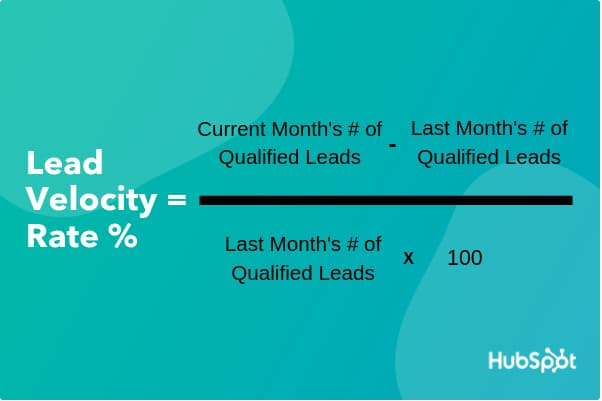
Simply subtract your last month's qualified leads from your current month, divide by last month's qualified leads and multiply by 100. Easy as pie. That's your percentage increase from month to month.
Conversions
While a common metric across many marketing and SaaS reporting, conversion rate as it pertains to SaaS sales is equally important. Knowing the percentage of leads that turn into customers is vital to figuring out which of your sales strategies are working and which strategies need to get in the bin.
Calculating your conversion rate is done with another simple math equation: total number of sales divided by the number of qualified leads times 100. Easy peasy. There's your conversion rate.
Churn Rate
It's inevitable that some of your customers will unsubscribe or leave your service over time. You can't escape that reality. However, it's important to keep track of this percentage, be it month-to-month or annually. This percentage is known as your SaaS churn rate.
Depending on the period of time for which you want to calculate your churn rate, the equation is as follows: the number of customers who have left over the period of time/total number of customers over that period of time x 100.
While it's impossible to ensure that no one leaves your service, maximizing your conversions will help minimize the effect that your churn rate has on your total revenue.
MRR (Monthly Recurring Revenue)
The best way to calculate your short-term revenue is to calculate your MRR, or monthly recurring revenue. If you're looking to attract investors, this is the SaaS sales metric you want to keep as high as possible in your 409A valuation.
MRR is calculated simply by multiplying your total number of customers by the amount that they pay you monthly. While you shouldn't rely solely on MRR, keeping track of it over time can sometimes be more effective than tracking several other metrics at once, since MRR is directly correlated to many other metrics.
Keeping an MRR that grows month to month is a clear sign of a successful SaaS company.
CAC (Customer Acquisition Cost)
A slightly more complicated metric, but important nonetheless. Customer acquisition cost, or CAC, is how you calculate just how much it costs on average to nab a new customer.
Divide your sales and marketing costs during a specified period of time by the number of customers you've gained during this same time, and you'll come up with your CAC.
Now it goes without saying that this number will likely rise as you ramp up your marketing and sales efforts. However, there's no need to panic. Combining this start with the next one on the list will give you an accurate representation of just how much your SaaS business is growing.
CLV (Customer Lifetime Value)
How do you figure out exactly how much a customer is worth to you?
Thankfully there's a metric to calculate that, even if it's a little more complicated. Start by finding your customer lifetime rate. Divide the number 1 by your churn rate.
For example, if your churn rate is 2%, your customer lifetime rate would be 50.
Next, you'll need to calculate your average revenue per account, or ARPA for short. This is simply your total revenue divided by your total customers.
Finally, multiply your customer lifetime rate by your ARPA. This is your CLV!
While it takes several steps to get your CLV, it's a crucial metric. Finding your CLV allows you to figure out:
- How much a customer is worth on average
- How much they spend
- Their purchase frequency
5 SaaS Sales Strategies to Boost Revenue
So now that you know exactly what SaaS sales are, the differences from regular sales, and even some of the most important SaaS sales metrics to calculate, why not go over some of the best sales strategies out there?
Here are the top 5 proven sales tactics:
- Shorten your trial periods
- Optimize your email campaigns
- Upsell like a pro
- Offer annual plans at a discount
- Learn from failed conversions
Shorten Your Trial Periods
How often do you see full 30-day trial periods from SaaS companies trying to promote their product?
They're everywhere. And it's understandable. Having such a long trial period can be a hook to draw in more signups and potential customers. However, it's important to look at the bigger picture here. Your customers aren't really “trying” your service for 30 days. It's likely they've come to you seeking a solution to their problem, your service solves their problem, and within a short time frame, they've already decided whether or not to become a paying customer!
Of course, this won't hold true for every SaaS company out there. Depending on the service you're offering, the complexity, and the learning curve, it may potentially take more time to figure out if what you're offering is for them. But for most, 30 days is overkill.
Setting your trial periods to, say, a week would force your potentials to make their decision quicker and instill a sense of urgency.
Will you scare away some potentials? Possibly. The thing is, paying customers should be more important to you than people who sign up and then ghost you when it's time to pay up.
Just look at KashFlow.
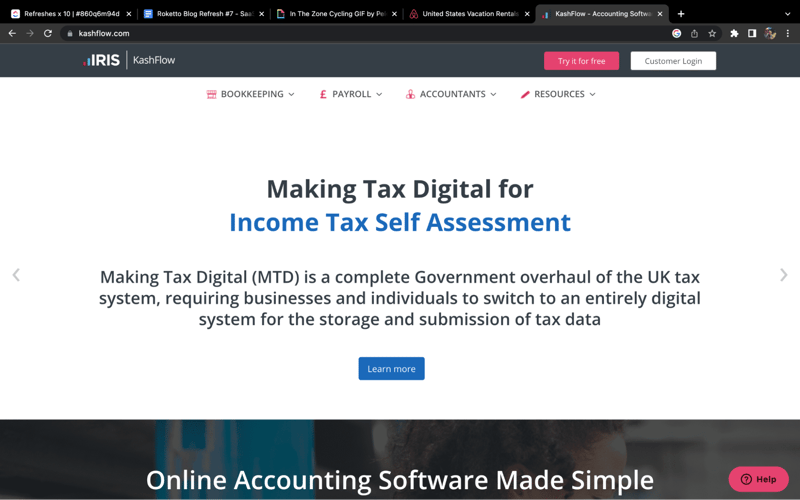
Their 14-day trial is perfect for those who want to get a feel for how their accounting software works, and it forces trial users to make up their minds quicker. KashFlow actually had a 60-day trial before switching to 14 days, and it yielded great results. They actually increased their conversions by 25%!
While not a blanket solution for every SaaS company, most companies should look into shortening their trial periods as a way to separate paying customers from those who have no interest in purchasing their service.
Optimize Your Email Campaigns
What's the best way to get in touch with your trial users after they've signed up? Well, email of course!
Don't let your trial users sign up and then immediately forget you exist. Setting your prospects up in an email campaign designed to nurture the relationship is vital to any SaaS sales strategy converting them into paying customers.
But how do you make email work for you?
- Don't be afraid to send a lot of emails. You aren't pestering your prospects. You're fighting for their attention.
- Make it personal. There's nothing worse than a basic domain email address. Use an email with a name attached to it.
- Use triggers to your advantage. Whether the customer is trying a new feature or the trial is about to end, send relevant emails based on this information.
So what does a good SaaS sales email look like? Have a look at what popular website builder Squarespace has done with their emails.
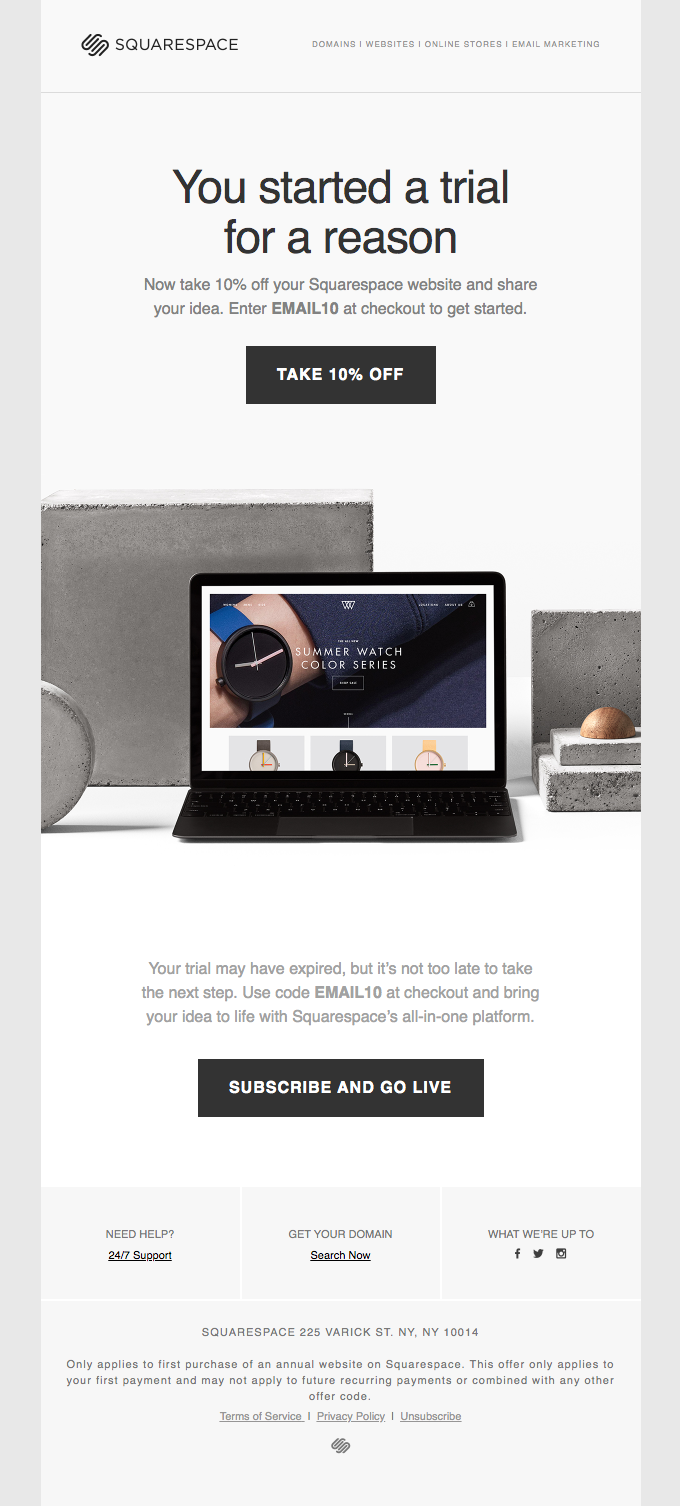
This customer's trial has expired, and they've now received this email offering a 10% discount, which is another excellent SaaS sales strategy. They've used convincing copy and a great headline to try and convert that trial user into a paying customer.
If you really want to optimize your SaaS sales email campaigns, SaaS automation is your best friend. There are tons of programs out there designed to help you achieve this. A program like Sendlane, which is designed to automate your email efforts while maintaining a personal touch, is a perfect example.
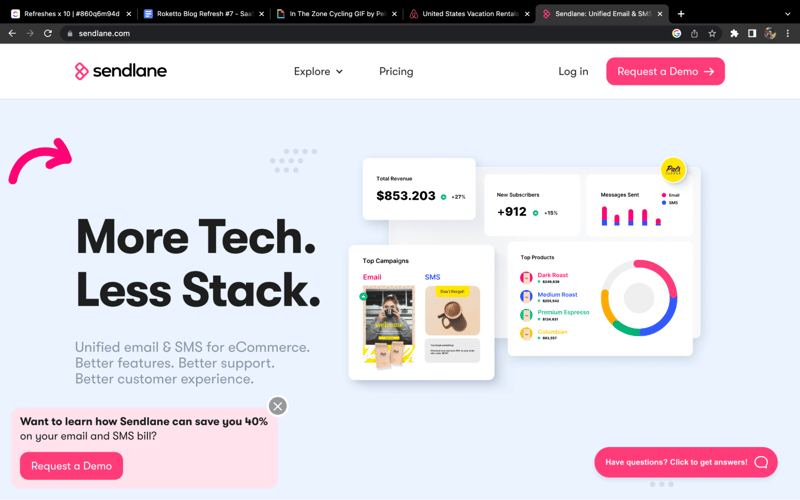
Don't sleep on emails. They'll help you go the distance and land that next paying customer.
Keep Demos Short and Packed With Value
Go ahead and look up the most common mistakes SaaS sales teams are making. A simple search will show that one of the biggest is demos that are too long and provide zero value to the customer.
Potential customers want to know what your product can do for them. Not every little feature is available to them. Try and limit your demos to 20 minutes tops. Your customer's patience will thank you for it.
It should also go without saying that your product demos are designed around converting your qualified leads, not creating those leads in the first place.
And if you really want to knock it out of the park with your product demos, start off with the good stuff. Don't save it for the end. Starting small and then going big picture is a first-class ticket to losing your prospect's attention!
Offer Annual Plans at a Discount
Because who doesn't love a good discount, am I right?!
But this isn't any old discount, this is a prepaid annual plan. Instead of the monthly fee, consider offering a yearly plan which averages out to be less monthly than your regular monthly plan.
There are many upsides to signing customers onto yearly plans. A few of those would include:
- Predictable revenue
- A lower churn rate
- Immediate revenue instead of gradual
- Actually benefits the customer in different ways as well!
Now, offering annual plans is no big secret in the B2B SaaS sales world. But that doesn't make it any less effective. There's a reason tons of SaaS companies offer these annual plans!
Check out how cold outreach automation program Snov.io handles their monthly and annual plan pricing:
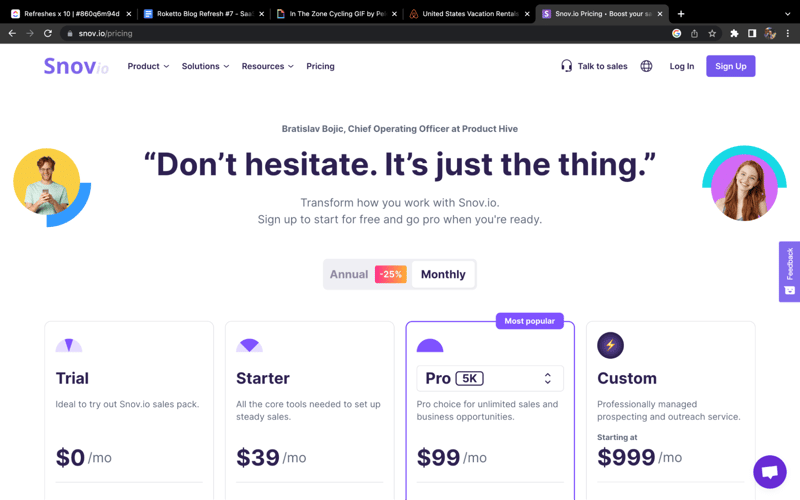
$39 a month for their starter plan. Not bad, eh? Now look at their yearly solutions:
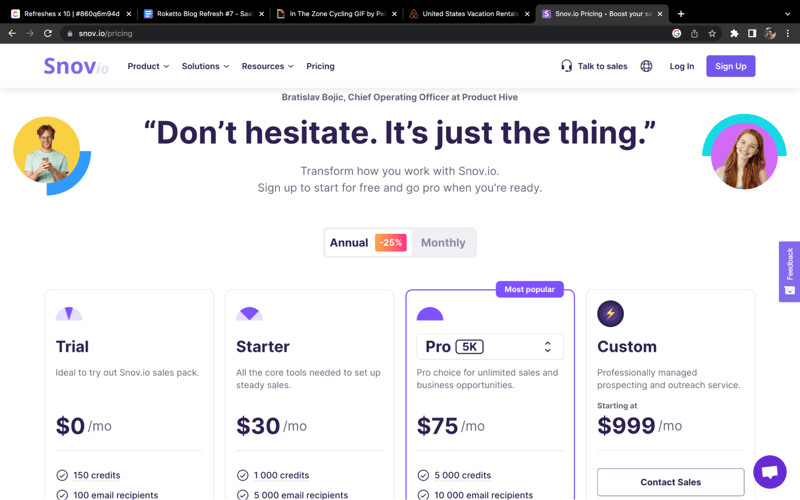
While the customer might be paying $660 upfront for the starter plan now, the monthly charge is actually $9 cheaper. They've also gone ahead and offered 2 months free on their annual plans, which will benefit the customer even further!
Do yourself a favour and don't sleep on yearly plans. They can help take your SaaS sales strategy to the next level and help boost your revenue significantly.
Upsell Like a Pro
Did you know it's easier to sell to an existing customer than to a new one? A lot easier, actually. According to Marketing Metrics: The Definitive Guide to Measuring Marketing Performance, your chances of selling to a new prospect are between 5 and 20 percent. While selling to an existing customer, your chances are between 60 and 70 percent.
So why not take advantage of these odds?
Upselling as part of a SaaS sales strategy involves selling a more expensive upgrade of your base-level service. But how is this done exactly? Well, for starters, you need to understand that not everyone is going to want to upgrade their service.
In fact, only a very small percentage will. But this small percentage adds up over time!
Some key factors you need to consider with upselling in SaaS are:
- Timing. If your customer isn't 100% satisfied with your current service, don't worsen the situation by attempting to upsell! Save the upsells for your happy customers.
- Being too pushy. As with many other aspects of life, sometimes no simply means no. Don't damage the customer relationship by being overly pushy with your upsells.
- Demonstrate value. An upsell won't sell itself. It's on you to know your service inside and out and be able to show your customer why they need this upgrade.
If you aren't upselling to your existing customers, you're leaving all kinds of money on the table. Simple as that.
Types of SaaS Sales Models
Solution Selling
As a consultative sales model commonly used in SaaS sales, solution selling focuses on understanding and addressing potential clients' unique requirements and pain points. That means identifying their problems, proposing customized solutions, and building relationships based on trust and value.
Customer centricity is the core of this approach. It requires sales teams to be skilled at active listening, asking probing questions, and providing relevant solutions that align with the prospect's goals.
Solution selling encourages long-term customer bonds and may increase customer satisfaction, retention rates, and more upselling opportunities.
Gap Selling
SaaS sales models, such as gap selling, concentrate on filling the gaps between a client's current and desired state. That requires the sales team to understand the challenges, pain points, and objectives and then offer solutions to alleviate problems while achieving goals faster.
Gap selling emphasizes value proposition, ROI, and the advantages of the SaaS service or product while seeking to build robust client relationships.
Challenger Sales Method
This popular approach is perfect for use in the SaaS industry as item[sizes challenge the customer's current thinking and offer new insights to drive sales.
The Challenger Sales Method involves the sales representative taking a strategic and proactive approach, rather than being passive, providing valuable insights and expertise to the clients. Using the Challenger Sales Method means the chat about the benefits of features of a product the potential customer already knows is eliminated. Instead, the sales rep takes control of the conversation and challenges the client's existing beliefs.
Once the prospect's trust is won, it's time to pitch them your alternative solution and close the deal.
Self-Serve Model
The self-serve model is a SaaS sales approach where customers have a self-directed buying experience. It typically involves a user-friendly website, free trials, and online demos to allow potential customers to explore the product independently.
Pricing plans are displayed clearly, and customers can sign up and purchase the software online without interacting with a salesperson.
Support is usually provided through chatbots, help documentation, and online communities. The self-serve model is efficient and scalable as it minimizes sales interactions. Still, it requires a highly intuitive product, comprehensive documentation, and effective marketing strategies to attract and convert customers.
How to Use Inbound Marketing to Drive SaaS Sales
Are you looking for a powerful approach to drive SaaS sales? Inbound marketing is the answer!
Start by creating valuable content that resonates with your target audience. This could include:
- White papers
- Ebooks
- Blogs
Optimizing your website and content with relevant keywords is recommended to improve search engine visibility. Utilize social media platforms, such as Twitter or LinkedIn, to engage with your audience while building a community of loyal followers.
Try nurturing leads and gathering prospect information by implementing email marketing campaigns that showcase your offerings.
SaaS sales and inbound marketing go hand in hand. Together they can help you attract, engage, and convert prospects into paying customers, leading to increased business growth and more SaaS sales.
SaaS Sales Summary
Above all else, SaaS sales strategies are about two very important points: knowing your service inside and out, and knowing the SaaS marketing metrics you need to track. Expert knowledge of your service is vital to being able to convey to your potential how your service will benefit them. Studying the SaaS sales metrics listed above is how you'll know if your efforts are paying off in the long run.
To summarize our favourite SaaS sales tips:
- Shorten Your Trial Periods
- Optimize Your Email Campaigns
- Keep Demos Short and Packed With Value
- Offer Annual Plans at a Discount
- Upsell Like a Pro
So implement the strategies, track the metrics, learn from your mistakes, and you'll knock it out of the park with your SaaS sales plan.
Still Unsure Where to Go From Here?
Even with your newfound knowledge, navigating the world of SaaS sales can be unforgiving, to say the least. There's no shame in asking for a little help. Why not drop us a line? We provide SaaS marketing services that enable your sales team and help to accelerate your SaaS growth.

Ulf Lonegren
Ulf Lonegren is CEO and Co-Founder of Roketto, where he has led digital marketing strategy for over 15 years. With extensive experience in both traditional SEO and emerging AI search optimization, Ulf has guided hundreds of SaaS and ecommerce companies through major search algorithm updates and platform shifts. His expertise spans from the early days of Google's algorithm changes through the current AI revolution, giving him unique insight into what actually drives sustainable search visibility. Ulf's approach focuses on fundamental optimization principles that adapt to new technologies rather than chasing trending acronyms, a philosophy that has helped Roketto's clients achieve measurable growth across multiple search paradigm shifts.












2.png)
2.png)

